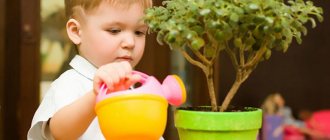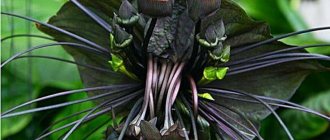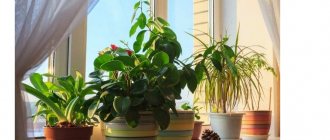Plants in the house should be safe for everyone who lives in it.
Home is a comfortable and safe place for all family members. You need to remember this every time you buy something for the interior, including indoor plants. If there are small children in the house, the issue of safety becomes doubly relevant.
Plants that should not be placed in the nursery
Plants with poisonous juice that irritates the skin and mucous membranes should not be placed in a nursery.
These include:
- Dieffenbachia,
- Yucca,
- Monstera,
- Alocasia,
- Oleander,
- Ekhmeya,
- Spurge,
- Ficuses.
It is not recommended to place plants with thorns or thorns that can harm the physical body in nurseries with children under 14 years of age:
- cacti,
- aloe.
There is no need to place the following plants:
- Emitting a strong aroma that makes your head hurt.
- Causing allergic reactions.
- Do not place plants with bright, appetizing but poisonous fruits, such as nightshade.
- Plants that are difficult to care for and cannot be moved or rotated frequently.
- Very fragile plants that break quickly.
TOP 12 best plants for a child's room
Flowers in a nursery will purify the air and enliven the interior
The list of flowers that are useful and safe for the health of a boy or girl includes a variety of plants - ampelous and erect, low-growing and tall, decorative-flowering and deciduous.
Sansevieria
Sansevieria, or mother-in-law's tongue, is one of the least demanding plants. Its beauty lies in its dense, sword-shaped leaves arranged in dense rosettes. Several varieties of mother-in-law's tongue can be used to create multi-tiered, colorful compositions that are sure to become the center of attention.
Sansevieria does not require high humidity or regular watering.
The main requirement is thorough watering, fertilizing in the warm season and periodically cleaning the leaves from dust.
Other common names for this flower are “mother-in-law’s tongue” and “pike tail.”
Lemon Tree
You can grow any citrus tree yourself by sowing a seed from a store-bought fruit. A lemon, tangerine or orange tree is the best decoration for a child's room. The exotic plant grows into a beautiful tree and, under optimal conditions, flowers and bears fruit.
Lemon tree leaves saturate the air with essential oils that have antibacterial properties and kill germs and viruses. Your child will love watching the citrus tree grow and develop.
With proper care, a lemon tree can even bear fruit.
Kalanchoe
In the children's room you can place all types of towers. All large families have the ability to keep out bacteria, stop bleeding and speed up healing:
- With minimal care, Kalanchoe Blossfeld will delight you with bright red, yellow or orange flowers;
- Callanchoe pinnate will help cure a runny nose, if necessary;
- Kalanchoe laciniata, or Kalanchoe antler, decorates the room with its sculptural leaves, cut into several fragments.
They are hypoallergenic, safe for the eyes and do not require special care.
Chlorophytum
Chlorophytes are the best purifier for home air saturated with dust, harmful chemicals and dangerous bacteria. Its leaves can collect up to 80% of toxins and pathogens overnight in the immediate vicinity of the pot. Chlorophytum tolerates dry, even air well and grows actively both in the sun and in the shade. A few pots of chlorophytum can liven up a child's room with long flower stems and lush "fountains" of greenery.
One of the most useful indoor plants is chlorophytum.
Violet
Violets are the perfect choice for a girl's room. They are non-toxic, undemanding and even tolerate north-facing windows. Thanks to the huge variety of shapes and colors of leaves and buds, you can create an original flower arrangement. Place pots of violets in the window and you can admire violets in bloom all year round.
Violets can be grown from a single leaf
Cypress
The cypress tree is shaped like a miniature Christmas tree, but has soft, scale-like needles. This tree is called a green vacuum cleaner because of its ability to collect dust, dirt and airborne bacteria on the surface of its branches. In order for the flower to effectively cope with this task, it is recommended to take a shower regularly. Cypress saturates the air with phytoncides, which have a beneficial effect on the respiratory system (especially for children suffering from bronchitis and bronchial asthma).
Cypress trees are excellent at purifying the air.
Decembrist
Grednik is a type of forest cactus without thorns.
Christmas cactus (Schlumbergera) in a pot
Its articulated leaves join together to form a dense, lush bush. It usually blooms in the winter before the New Year, covered with numerous white, red, pink or crimson buds.
To prevent the blooming Decembrist from dropping its flowers, do not turn the pot against the light and do not move it to another place as soon as the buds appear.
Begonia
Begonias release essential oils into the air, which have a beneficial effect on the respiratory system. For a child, having such a flower is not only useful, but also aesthetically pleasing. Both flowering varieties of begonias with flowers and deciduous varieties with unusual patterns on the leaves will be pleased.
Begonias release beneficial essential oils into the air.
Hibiscus
Peace hibiscus or Chinese rose attracts attention with its glossy leaves and brightly colored buds that are odorless. A young specimen that does not take up much space is suitable for a child’s room. When the bush reaches a large size, it can be moved to the living room - the hibiscus will look great in any part of the house.
Hibiscus can grow to large sizes and should be trimmed.
Tradescantia
You can use Tradescantia Ampelia to create a green corner in your children's room. It grows quickly and in 2-3 months turns from several small sprouts into a beautiful plant. The shrubby green tridescantia is colorful, with the most popular varieties having leaves with green, white and purple stripes. The shrub beauty will grow well in brightly lit windows and on the north side of the house.
It has one drawback: it grows quickly.
Peperomia
Of all the varieties of peperomia for a child's room, it is best to choose blunt-leaved or palmate varieties. They are able to accumulate water in their stems and leaves, so they do not require frequent watering, sprinkling and high humidity. According to experienced gardeners, you need to try very hard to kill periromia: it can adapt to both a lack of light and direct sunlight.
Only 50 types of peperomia can be grown at home
Spathiphyllum
Lucky flower or lady's happiness is the common name for Spatyphyllum. The glossy leaves look good alone or in combination with other houseplants.
This flower is also called "Lady Luck" and is considered a promise of good luck.
Spathiphyllum cleanses and humidifies the air well, evaporating moisture through its numerous leaves. The appearance of flower stems is a good omen and foretells good understanding between spouses, as well as between children and parents.
Don't try to cram a large number of pots into a child's room. 2-3 large specimens or 3-4 small plants are enough. Otherwise, the child may suffer from a lack of oxygen at night, when flowers actively release carbon dioxide.
Planting currants in 2022: favorable days, when to plant, care calendar
22 Feb 2022 0
Currants are a popular garden crop with delicious berries,…
More details
Useful tips
Indoor violet (Saintpaulia)
Indoor violet - many people associate it with the arrival of spring, and the leaves of the plant, shaped like a heart, are considered a talisman for lovers. Extremely unpretentious, but blooming almost all year round, Saintpaulias have a positive effect on the atmosphere in the house: they awaken in a person a desire to act, develop sociability and love of life, and bring joy and harmony to the house. They have a soft, calming energy, help to tune into a positive mood, get rid of tension and insomnia. In a house where violets bloom, love and harmony reign. The influence of violets on humans is multifaceted, it all depends on the color of their flowers.
White Saintpaulias will be appropriate in any room. They calm, relieve anxiety and worries, help cope with excessive irritability and fatigue, clear the space from the negative influence of bad thoughts, and help keep the house clean.
Pink and red Saintpaulias are best placed in the kitchen. They harmonize the energy in the home, protect against illness, improve mood, give a feeling of calm, help a person feel the joy of communication and work, and get rid of bad habits, in particular, overeating.
Violets with blue flowers are especially useful for creative people. They relieve despondency and apathy, help cope with depression, give inspiration, fill space with creative energy, and help a person reveal his creative potential.
Saintpaulias with purple flowers clear the space of the energy of mistrust, help achieve mutual understanding between the residents of the house, promote spiritual growth, elevating thoughts, strengthening character, and developing intuition. True, they have no place in children's rooms and offices.
Feeding peppers after planting in open ground: the most effective and best means
22 Feb 2022 0
To get a good harvest of peppers, the plants are fed…
More details
Tubers
Chlorophytum
Chlorophytum is suitable for the home of the youngest researchers, because it is safe and even if eaten, will not cause a food reaction. In addition, this plant fits well in hanging pots, being both visible and out of reach.
Chlorophytum purifies the air from harmful impurities, serves as a dust filter, and produces a large volume of oxygen. Of course, it blooms unpresentably, but the striped white-green leaves are good in themselves.
Properly selected plants will not only decorate the interior of the nursery, but will also improve the health of the air, and will also become excellent helpers for the baby in the fight against diseases.
Planting pepper seedlings in open ground in 2022: when to plant, timing
21 Feb 2022 0
Pepper is a heat-loving crop, demanding on climatic conditions....
More details
Pumpkin
Hygiene
In order for plants to bring real benefits, they must be taken care of. Now we are not talking about regular watering and fertilizing, but about basic hygiene requirements. Dust is recognized as one of the main enemies. Firstly, it is a kind of transport for pathogenic bacteria and other microorganisms. Secondly, it is the dust that settles on the foliage that interferes with the normal processes of photosynthesis, and, therefore, reduces the potential beneficial properties of the plant.
The second dangerous enemy is mold. Spores of pathogenic fungi in a “dormant” state will not cause trouble, but when favorable conditions arise, they can become active almost instantly and give life to the mycelium. Such conditions can arise in the absence or improper arrangement of drainage, in cases of disturbance of water balance and ventilation. Of course, a children's room is not a place for breeding colonies of pathogenic fungi. Therefore, growing plants should be approached consciously: theoretical preparation is required.
Sowing cucumbers in March 2022: when to plant, timing
21 Feb 2022 0
Cucumbers are the undisputed leaders in garden beds. Almost every…
More details
Trees and shrubs
Lemon or tangerine tree
Growing a citrus plant in a room is much more difficult than caring for an unpretentious chlorophytum, but the result is definitely worth it. The essential oils that these trees contain have excellent bactericidal properties. In addition, plants of the citrus family have a calming effect, relieve irritability and fatigue, and even help solve problems of restless sleep. Finally, a small lemon or tangerine, or even a few fruits ripening on a small branch, usually delight children. To wait for the harvest, you need to carefully care for the plant: regularly water, loosen and fertilize the soil, but even if the tree does not bear fruit, its leaves will still exude a subtle citrus aroma - real exoticism right on the windowsill!
Where to buy: Green Country, IKEA, Starlight Cash & Carry, Flower Shop. Cost: 500-600 rub.
Tatyana GoldinaDon't miss all the most important and interesting things! Subscribe to our weekly newsletter!
Useful flowers for the home
There are several types of useful flowers for the home.
They are mainly used for medicinal purposes, as well as for oxygen purification, these include:
- Aloe. People often call it agave. This flower is simply a storehouse of useful properties. It is difficult to name all the diseases and injuries for which it is used, but most often it saves from colds, intestinal disorders, stomach pain, and also promotes the rapid healing of wounds and cuts.
- Kalanchoe. The flower was brought to us from Germany. It perfectly cleans oxygen from pathogenic bacteria, so that it will be difficult to catch a cold if such a protector is available in the house. Excellent against runny nose and sore throat.
- Spathiphyllum. An indispensable “vacuum cleaner” for cleaning indoor air. Actively fights all harmful substances in the air and enriches the space with the necessary amount of oxygen. All the advantages of the plant include the fact that it blooms very vigorously and beautifully, and this improves your mood in winter.
- Geranium. There is no better cure for depression than having this flower in the house. This natural antidepressant will improve sleep and normalize the nervous system.
When purchasing a plant, one should not forget about several poisonous representatives of the plant world, and these are dieffenbachia, oleander and azalea.
What not to grow
Some indoor flowers, which attract adult gardeners with their exotic appearance, are dangerous for small children. A child can get poisoned or develop an allergy if he eats a leaf or inhales pollen from a tropical plant. The essential oils released in nature repel insects, and the children's room will be filled with an alarming atmosphere. Large, tall palm trees can create scary shadows at night.
Poisonous
The stems of some plants contain poisonous sap that causes food poisoning and skin burns. A toxic substance also appears on the surface of the leaves. Poisonous ones include:
- spurge;
- dieffenbachia;
- monstera;
- oleander.
Nightshade and Madagascar palm produce poisonous berries that look like small tomatoes. It is better not to place flowers with fruits in the nursery, as the child will want to try them. Alocasia leaves contain alkaloids, hydrocyanic acid. The Euphorbiaceae family includes poinsettia and croton. Their milky juice irritates the skin.
Traumatic
Thorns and thorns are dangerous for preschool children. It is better to postpone getting acquainted with cacti and succulents. Hard leaves with sharp edges, like those of tall varieties of sansevieria, are also traumatic for children. Therefore, you should choose low-growing species with small rosettes.
Causing fear
Children are frightened by plants with thick, dark green foliage. A sundew with jagged wings will seem scary. An exotic flower eats insects. Philodendron, scindapsus, dracaena, palm trees look large for a child and seem like monsters watching from a dark corner.
Allergens
Not all flowering plants cause irritation of the mucous membranes and not in all children. But until the age of 2-3 years, it is better not to test the strength of children’s fragile immunity. Allergens include azalea, pelargonium, and hydrangea.
If the child does not suffer from allergies, they can be grown as they are generally good for the environment and health.
Orchids, lilies, and gardenias are not suitable for children's rooms because of their strong odor and allergenicity. The aroma concentrates in the air, causing headaches and disrupting sleep.
Additional tips and tricks
How to teach children to take care of plants and organize room space:
- introduce the flower as a new friend and offer to give it a name;
- you can make a pot from a plastic bottle, a yogurt cup and decorate it with your own hands;
- to save space, hang flowers at different heights, place them on cabinets and shelves, use whatnots;
- if you arrange a place for a home garden next to your desk, the light from a table lamp in the evening will additionally illuminate light-loving plants;
- trees and large shrubs will be easy to move during harvesting if you place them on platforms with wheels.
Using indoor flowers in the nursery, you can create a corner of wildlife, place an aquarium, a cage with a hamster or a parrot nearby.
Share link:
Flowers that cause concern
Unfortunately, there are many bright indoor flowerpots that are not advisable to be placed indoors for children. Despite their attractiveness, they can have a detrimental effect on the baby’s well-being. Therefore, prudent parents choose only useful plants for the nursery in order to contribute to the successful development of the baby. Let's consider several options for indoor flowers that can lead to unexpected health problems in a child.
Orchid
This royal flower will not leave anyone indifferent. Its delicate buds of various tones can be looked at endlessly. Therefore, they are often bought to decorate home interiors. And how amazing an orchid looks in a children's room! A child can admire its beauty every day and develop a craving for beautiful things. But is this plant so harmless?
According to experts, an orchid can have a detrimental effect on a person’s general condition. This is reflected in the following factors:
- insomnia;
- dull headache;
- feeling tired;
- allergic reactions to strong aroma;
- despondency or depression.
Considering these points, it is wise to think: is it worth putting these flowers in the children's room? Many parents have come to the conclusion that “God protects the careful,” so they place the orchid in the hallways, in the kitchen or in the winter garden on the balcony.
Ficus
Lovers of lush indoor greenery often grow large flowerpots:
- palm;
- dracaena;
- yucca;
- ficus;
- Chinese rose.
Each of them has its own characteristics, therefore, when taking care of babies, you should consider the pros and cons
For example, when placing a ficus in a children's room, it is important to remember its size and toxicity.
Of course, with the help of this luxurious plant it is easy to create a unique room design for a child. Wide fleshy leaves located on a powerful trunk cause unprecedented admiration. The baby can even feel like the master of the jungle without leaving home. But if he breaks even one leaf, disaster may happen.
Whenever damaged, the ficus produces milk, which sometimes causes skin irritation. What if it gets into a child’s eyes? Perhaps no one would want to check this information for themselves. Wise parents will think twice before placing a ficus in their child’s room.











